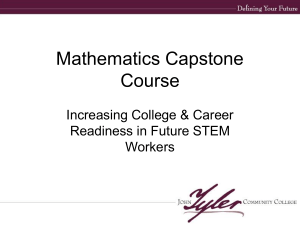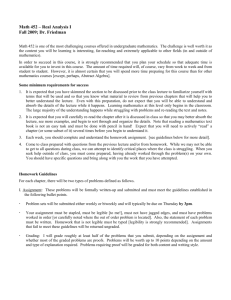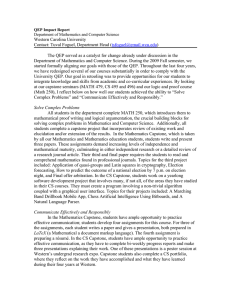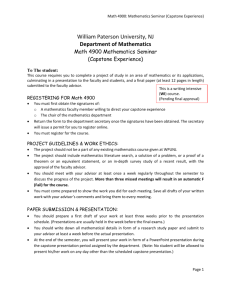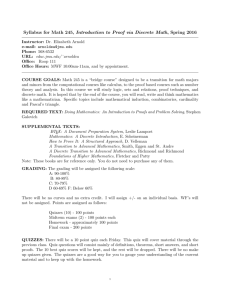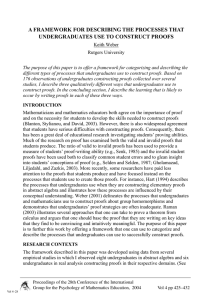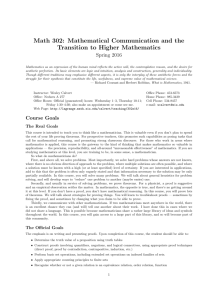Math Capstone Paper Guidelines for Undergraduates
advertisement
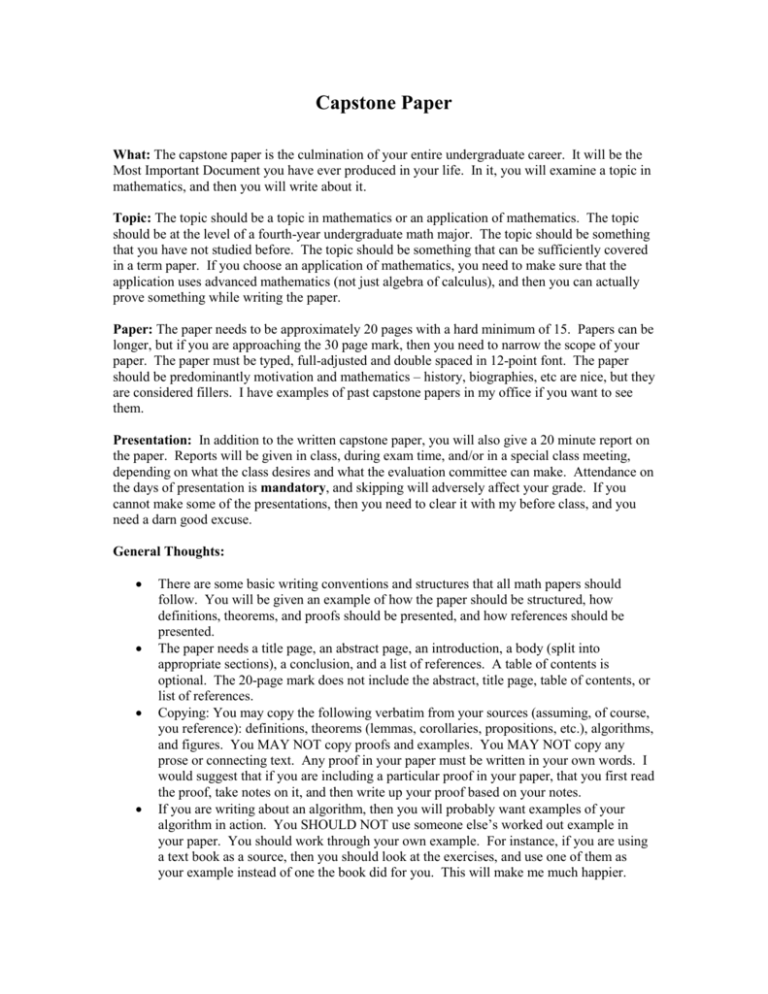
Capstone Paper What: The capstone paper is the culmination of your entire undergraduate career. It will be the Most Important Document you have ever produced in your life. In it, you will examine a topic in mathematics, and then you will write about it. Topic: The topic should be a topic in mathematics or an application of mathematics. The topic should be at the level of a fourth-year undergraduate math major. The topic should be something that you have not studied before. The topic should be something that can be sufficiently covered in a term paper. If you choose an application of mathematics, you need to make sure that the application uses advanced mathematics (not just algebra of calculus), and then you can actually prove something while writing the paper. Paper: The paper needs to be approximately 20 pages with a hard minimum of 15. Papers can be longer, but if you are approaching the 30 page mark, then you need to narrow the scope of your paper. The paper must be typed, full-adjusted and double spaced in 12-point font. The paper should be predominantly motivation and mathematics – history, biographies, etc are nice, but they are considered fillers. I have examples of past capstone papers in my office if you want to see them. Presentation: In addition to the written capstone paper, you will also give a 20 minute report on the paper. Reports will be given in class, during exam time, and/or in a special class meeting, depending on what the class desires and what the evaluation committee can make. Attendance on the days of presentation is mandatory, and skipping will adversely affect your grade. If you cannot make some of the presentations, then you need to clear it with my before class, and you need a darn good excuse. General Thoughts: There are some basic writing conventions and structures that all math papers should follow. You will be given an example of how the paper should be structured, how definitions, theorems, and proofs should be presented, and how references should be presented. The paper needs a title page, an abstract page, an introduction, a body (split into appropriate sections), a conclusion, and a list of references. A table of contents is optional. The 20-page mark does not include the abstract, title page, table of contents, or list of references. Copying: You may copy the following verbatim from your sources (assuming, of course, you reference): definitions, theorems (lemmas, corollaries, propositions, etc.), algorithms, and figures. You MAY NOT copy proofs and examples. You MAY NOT copy any prose or connecting text. Any proof in your paper must be written in your own words. I would suggest that if you are including a particular proof in your paper, that you first read the proof, take notes on it, and then write up your proof based on your notes. If you are writing about an algorithm, then you will probably want examples of your algorithm in action. You SHOULD NOT use someone else’s worked out example in your paper. You should work through your own example. For instance, if you are using a text book as a source, then you should look at the exercises, and use one of them as your example instead of one the book did for you. This will make me much happier. I will allow you to copy pictures, charts, and figures, but be careful. If you fill up your paper with someone else’s pictures, then you haven’t really written the paper, have you? Timeline (assuming a Friday schedule): February 5 – Topic is due in writing. In addition, you must clear the topic with me verbally. February 12 – Reading list is due. I need a list of sources that you plan on reading for your paper. Sources can be papers, texts, books, or internet sites. There is no minimum for the number of sources, but you should have at least one solid (non-internet) source. Beginning of March – Practice writing. You will do a short (2 pages) paper on a topic of my choice. March 12 – Mini-presentations. You will give a short (five minute) talk on what your paper will be about. March 12 – Abstract due. This is a short description of what the paper will contain. Consider it an outline in paragraph form. It should be one or two paragraphs long, and definitely less than a page. By this point of time, you should have done enough reading to know, in detail, what will be contained in your paper. April 2 – Paper is due to me. You may turn it in earlier, if you wish. April 9 – Absolute last day I will give the paper back, with comments on what you need to fix before giving this to the evaluation committee. If I get the paper earlier than April 2, you will probably get it back earlier than April 9. April 21-23 – Tentative days for the presentation. I may hold them during exam week, if that works better for all. April 23 – Paper is due.
